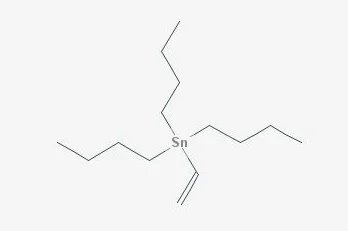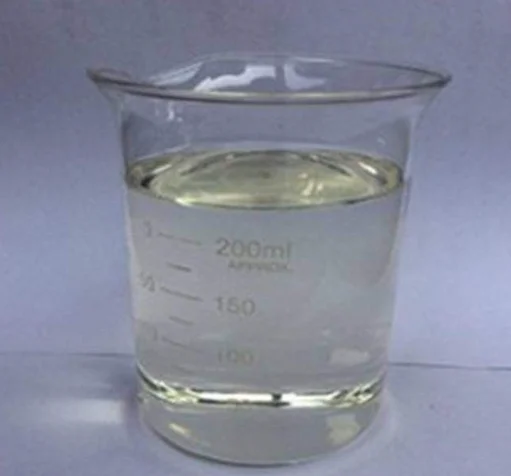- This topic is empty.
-
AuthorPosts
-
2025-08-27 at 4:42 pm #10462
Introduction
Tributyl Vinyl Tin (CAS No.: 7486-35-3) is an important organotin compound widely used in advanced organic synthesis. Known for its role in palladium-catalyzed coupling reactions, particularly the Stille reaction, it offers high versatility in forming carbon–carbon bonds. In this blog post, SACH BIOTECH, a high quality organotin compounds manufacturing factory, will share the properties, synthesis methods, and advantages of organic synthesis reagent tributyl vinyl tin for sale.
Basic Information and Properties of Tributyl Vinyl Tin
* Chemical Name: Tributyl(vinyl)tin
* Molecular Formula: C₁₄H₃₀Sn
* Molecular Weight: 317.10
* Appearance: Colorless to light yellow transparent liquid
* Density: 1.085 g/mL at 25 °C
* Boiling Point: 104–106 °C at 3.5 mmHg (lit.)
* Melting Point: Below 0 °C
* Refractive Index: 1.477–1.479 (20 °C)
* Flash Point: 43 °C
* Vapor Pressure: < 0.1 mmHg (20 °C)
* Solubility: Insoluble in water; soluble in chloroform; slightly soluble in ethyl acetate
This set of physical and chemical properties makes tributyl vinyl tin suitable for controlled, moisture-free synthetic environments, especially in inert atmospheres.

Synthesis Method of Tributyl Vinyl Tin
Tributyl vinyl tin (CAS No.: 7486-35-3) can be synthesized via the reaction between vinyl magnesium bromide (Grignard reagent) and tributyltin chloride. This approach yields the target compound with high purity when performed under strictly anhydrous and oxygen-free conditions.
The general steps include:
1. Preparation of Vinyl Magnesium Bromide – A Grignard reagent formed by reacting vinyl bromide with magnesium metal.
2. Nucleophilic Substitution Reaction – The vinyl Grignard reagent reacts with tributyltin chloride, replacing the chloride atom and yielding tributyl vinyl tin.
3. Purification – Distillation under reduced pressure to obtain the pure liquid.
Applications of Tributyl Vinyl Tin in Organic Synthesis
1. Palladium-Catalyzed Coupling (Stille Reaction)
Tributyl vinyl tin is a highly effective vinyl donor in the Stille coupling reaction. In this transformation, it reacts with aryl or vinyl halides (or triflates) in the presence of a palladium catalyst, forming new C–C bonds.
* Example:
* Reacting tributyl vinyl tin with aryl bromides yields substituted styrenes.
* Reaction with vinyl halides can produce conjugated dienes.
2. Formation of α,β-Unsaturated Ketones
When reacted with acid chlorides under palladium catalysis, tributyl vinyl tin produces α,β-unsaturated ketones. This method offers a direct route to these highly valuable intermediates in pharmaceutical and fine chemical synthesis.
3. Conjugate Addition Reactions
Tributyl vinyl tin can participate in 1,4-addition reactions with α,β-unsaturated carbonyl compounds, allowing for the construction of complex molecules with precise control over double bond placement.
4. Specialized Vinyl Nucleophile Applications
The compound serves as a vinyl nucleophile in reactions with bromoacetylene or bromoaromatic compounds, enabling synthetic pathways that are difficult to achieve via conventional vinyl halides.

Advantages of Using Tributyl Vinyl Tin in Synthesis
* High Selectivity: Palladium-catalyzed couplings with tributyl vinyl tin generally show excellent selectivity for desired C–C bonds.
* Functional Group Tolerance: Compatible with a wide range of functional groups, enabling late-stage modifications of complex molecules.
* Controlled Reactivity: Its relatively stable liquid form and low volatility allow for safer handling compared to more reactive vinylating agents.
Safety and Toxicity Considerations
While tributyl vinyl tin (CAS No.: 7486-35-3) is a powerful synthetic reagent, it carries significant health and environmental hazards.
Toxicological Profile
* Human Toxicity: Harmful if swallowed, inhaled, or absorbed through the skin. Potentially damaging to the nervous and reproductive systems with prolonged exposure.
* Ecotoxicity: Extremely toxic to aquatic life, with long-term environmental persistence.
Hazard Classification
* Category: 6.1 Toxicant
* UN Number: 2788
* Packing Group: III
* Risk Phrases:
* R21: Harmful in contact with skin
* R25: Toxic if swallowed
* R36/38: Irritating to eyes and skin
* R48/23/25: Danger of serious damage to organs through prolonged exposure
* R50/53: Very toxic to aquatic organisms, may cause long-term adverse effects in the aquatic environment
* Safety Phrases:
* S36: Wear appropriate protective clothing
* S45: Seek immediate medical advice in case of accident
* S60: Dispose of hazardous waste properly
* S61: Avoid release into the environment
Storage and Transportation Guidelines
Proper handling and storage are crucial for maintaining reagent integrity and safety.
* Storage:
* Store in a cool, dry, well-ventilated area
* Keep container tightly sealed
* Store under inert gas (nitrogen or argon) to prevent oxidation or hydrolysis
* Keep away from oxidizing agents
* Transportation:
* Follow international transport regulations for hazardous goods
* Use professional chemical transport services
* Ensure containers are impact-resistant and leak-proof
* Label according to GHS standards and local laws
Environmental Impact and Waste Disposal
Given its high toxicity to aquatic organisms, any spills or waste containing tributyl vinyl tin must be treated as hazardous chemical waste.
* Disposal Guidelines:
* Incineration in a licensed hazardous waste facility
* Avoid disposal into drains or natural water sources
* Decontaminate containers before recycling or disposal
* Spill Management:
* Contain spill with inert absorbent material
* Wear full protective gear
* Transfer collected material to a labeled hazardous waste container
Conclusion
Tributyl Vinyl Tin (CAS No.: 7486-35-3) is a specialized organotin reagent that plays a critical role in modern organic synthesis, particularly in C–C bond formation via palladium-catalyzed coupling reactions. Its reactivity and functional group tolerance make it invaluable in pharmaceutical, agrochemical, and fine chemical research. However, its high toxicity demands strict adherence to safety protocols, responsible storage, and environmentally conscious disposal.
-
AuthorPosts
- You must be logged in to reply to this topic.